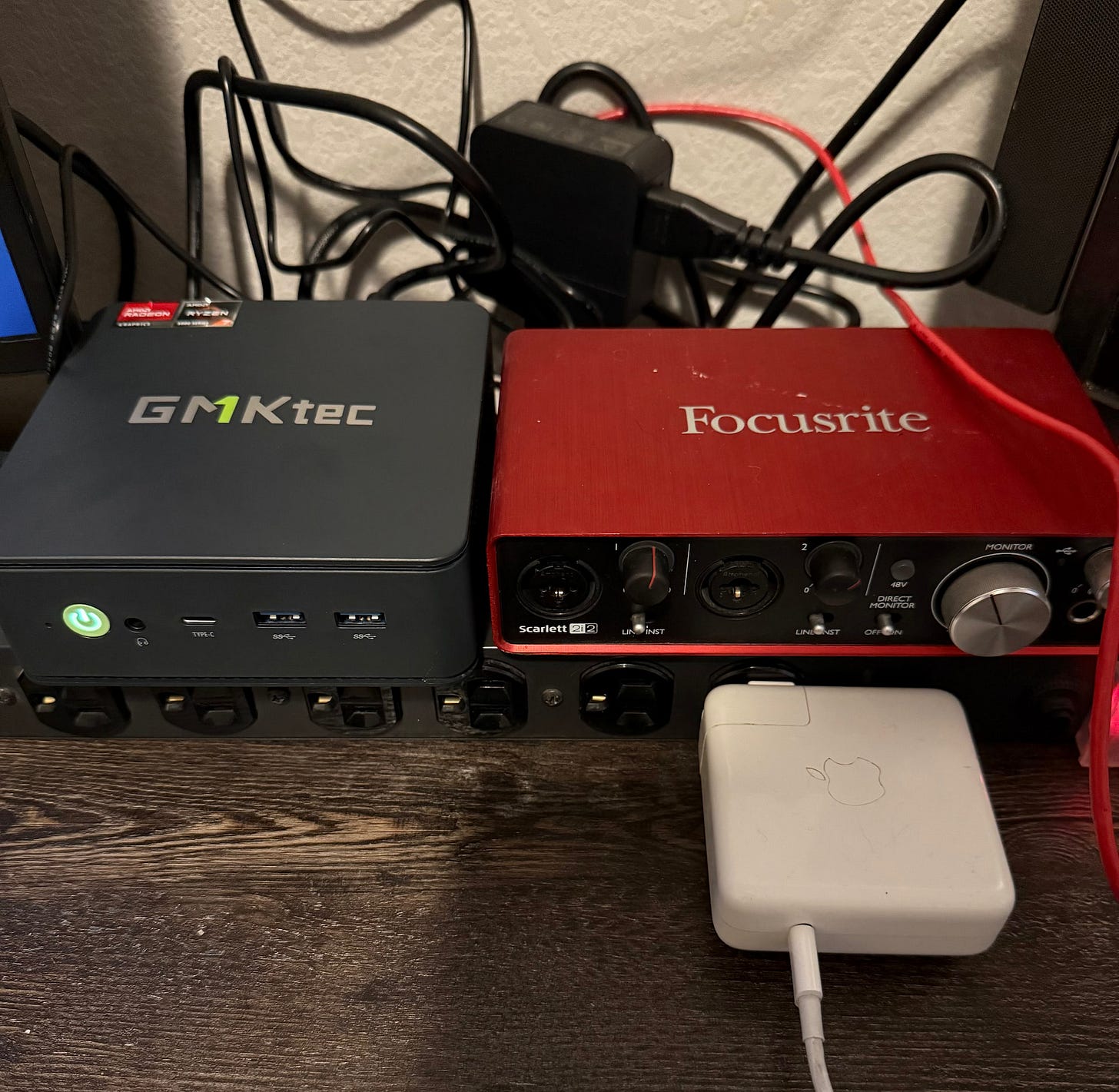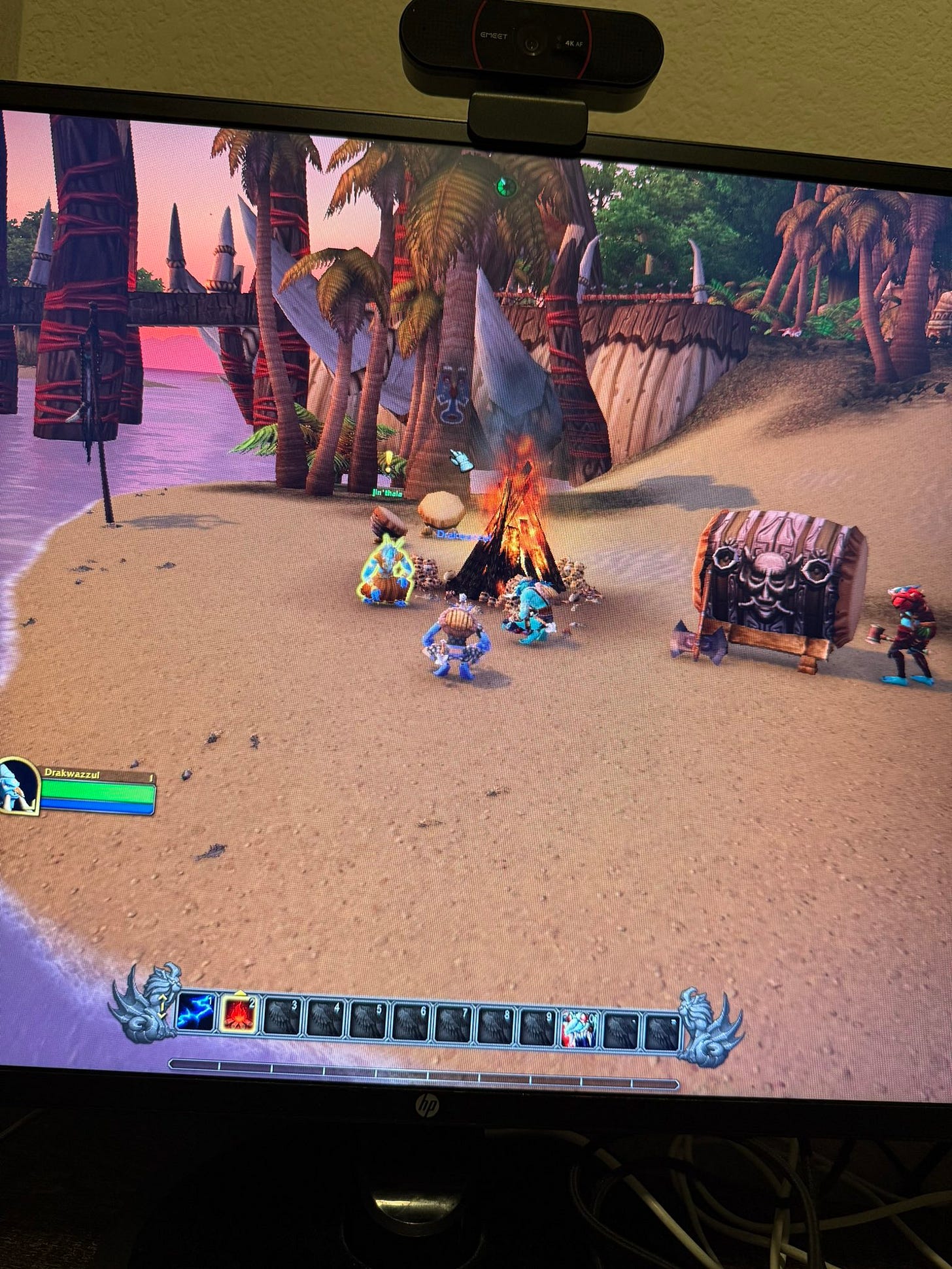GMKtec Review
I.
My desktop PC finally shat the bed. I'm not entirely sure what's wrong with it because it boots up just fine (kindof), but my best guess is there's an issue with some component on the motherboard itself, or the GPU is fried. One of these is an $80 fix, the other is a several hundred dollar fix, and both are a gamble.
Because of this, I've been working entirely off a laptop. Not exactly a fun experience when you're accustomed to multiple monitors, but country boys make do.
I recently came across a mini gaming PC (affiliate link, btw) on Amazon that seemed fairly interesting. Of course, I was initially hesitant because I've only ever built my own PCs in the past, and have so far steered clear of prebuilts for good reason.
But with a current price tag of $327.98, I figure it's affordable enough where even if I run into problems a few months from now, it won't feel like a major loss. Given this information (and my increasing levels of burnout from work and desire to unwind while traipsing through Azeroth) I did the only sensible thing I could think to do, and hit `Buy Now`.
II.
In typical Amazon fashion, the PC arrived later that evening. I knew it was going to be small—but I didn't expect it to be as small as it was. Please ignore the mess of the cable management. There's a reason I don't work in IT.
The fact that it's roughly the same size as my focusrite audio interface is a bit insane. If my pockets were a bit larger (or at least deep enough to afford a tailor), this would qualify as a true pocket PC.
The main drawback of its form factor is that there's not a whole lot of space for venting—the vents are found on either side of the device, so the side-by-side layout in the image above cuts off half of the circulation. For now, I've opted to move it to sit on top of my focusrite. It's a *tiny* bit wobbly, but at least it can breathe.
It's also impressively quiet. Whether this has to do with the nature of the small design, or some other aspect (such as weaker fans or the lack of a dedicated GPU) is beyond me, but it's nice not having to hear the loud WHIRRRRRRRR of a 10 year old GPU.
This particular variant doesn't have a *ton* of USB input options, but it's enough to at least handle everything I need to throw at it. It has four USB (3? 4?) slots, and one for a USB-C, so I can safely run my keyboard, mouse, webcam, audio interface, and external soundbar.
Slightly tangential, but I tried doing something similar with a Raspberry Pi 5, and even though it had enough USB ports to support everything (minus the soundbar), the focusrite was too much of a drain, so it'd cycle the Pi's power on a loop.
The Amazon listing says it can support a triple 4K display. I only have two monitors, neither of which are 4K, so I can't put that claim to the test, but the device only has two media outputs: one HDMI, and one DisplayPort. I assume you'd need some third party dongle to get that third output, but it feels odd to claim support for three screens when you can only natively support two out-of-the-box.
The last piece of I/O is the audio jack which, honestly, feels a bit cheap. This could very well be due to the fact that I haven't touched a native audio jack in years, so I'm probably spoiled with using dedicated audio hardware, but I had to twist my headphone cable in the slot to get everything to line up *just right* so it'll play audio in both sides of my headphones. I truthfully have no idea if this is how native audio jacks typically behave or not. It's not really a big deal though, since I won't be using that port anyway, but it's worth at least trying out for the review's sake.
III.
The PC is almost quite literally plug-and-play. I'm sure all prebuilts are like this, so I'm viewing this from the lens of somebody that's had to assemble the parts myself and diagnose and adjust if things go wrong during setup.
A few brief moments after hitting the power button, and I'm being gracefully swept through the Windows 11 Pro setup.
I've wanted to avoid Windows 11 for as long as possible, but it seems that I can't do that anymore—at least not feasibly. Sure, I can swap out the OS for whatever I'd like, but I'm also not going to be leaking government secrets on that device so I don't particularly care about telemetry and other New Windows issues. That being said, the setup for W11 seems to be a lot faster than that of W10 by a considerable margin, so it at least has that going for it.
The biggest problem though, and this was easily fixable, was that it's a Microsoft Windows device, which means that as per Microsoft's official specs on prepackaged bloatware slop, it came shipped with SIXTY FIVE (65) different programs.
Copilot was, understandably, the first to be deleted—get that AI bullshit OUTTA MY SIGHT.
A majority of these programs were dedicated language packs (I'm assuming) for Microsoft 365 and OneDrive. *Why* they all needed to be separate programs instead of just having it use the device's language is beyond me; I'm not the numpty in the C-Suite at Microsoft that decided that'd be a good idea.
Most of the software could be deleted in tandem... except for these language packs. I'm sure there's a way to do it programmatically, but if you're deleting them through the default Add & Remove Programs UI, you *have* to uninstall them one at a time. Trying to uninstall a second one while the first is being uninstalled just results in the first's being canceled. The uninstallation window for these also takes a strangely long amount of time to load, and an even longer amount of time to actually uninstall.
Whichever rat bastard of a PM or C-Suite chud over at Microsoft decided this is how it should be needs to have their fucking kneecaps removed.
IV.
Once I was suited and booted and had gotten everything cleaned up and configured to my liking (fresh wallpaper, theme, etc), the first thing I did was check out the specs. I was half expecting there to be some sort of bait-and-switch, but everything is as advertised.
It's packing an AMD Ryzen 7 5825U @ 2.0Ghz (integrated Radeon graphics), which is already a step above my old Ryzen 5 1600X, 32GB of DDR4 (vs my old 16GB), and a 1TB SSD.
No dedicated GPU, though.
For me personally, the lack of discrete graphics isn't a dealbreaker. I bought this thing solely because I wanted to play World of Warcraft again. There are a few other games I enjoy from time to time (MTG Arena, OSRS, Project Zomboid), but none of them are graphically resource-intensive, nor do I particularly *care* about high-quality graphics in video games.
If that's something of a concern and you want to play the latest COD on Ultra settings, then save your money and buy something else.
But if the latest-and-greatest high fidelity AAA dopamine-milking-machine isn't your speed, and you're fine with games that don't take advantage of the bleeding edge of graphical fidelity, or if you just need a solid little office machine to check your emails, then this does the job by a pretty considerable margin. I mean, shit, it outperforms my old gaming PC in every regard except for graphics, so it's *definitely* powerful enough to do some programming on or browse through Reddit.
V.
Of course, I've only had it for less than 24 hours. If it breaks within the next week, my opinion about it will understandably change.
It's too early to say definitively if it's any good, at least in regard to its lifespan, so I'll have to come back and update this if it breaks in the near future (or if we can make it to 2026).
But if you've got some extra cash burning a hole in your wallet, it's definitely worth picking one up.



